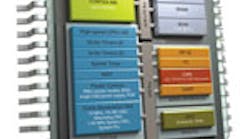NXP Announces First Integrated CAN Transceiver Microcontroller Solution
Eindhoven, the Netherlands: NXP Semiconductors has launched the LPC11C22 and LPC11C24, which the company calls the industry’s first integrated high-speed controller area network (CAN) physical layer transceiver and microcontroller with easy-to-use on-chip CANopen drivers.
Offered as a system-in-package solution, the LPC11C22 and LPC11C24 with integrated TJF1051 CAN transceiver combine complete CAN functionality into a LQFP48 package. The LPC11C22 and LPC11C24 are the latest additions to the LPC11C00 series of CAN 2.0B-compliant controllers.
The CAN physical layer is designed for up to 1-Mbit/s high-speed CAN networks and delivers optimal performance for industrial applications with state-of-the-art electrostatic discharge (ESD) protection, improved electromagnetic compatibility (EMC), and low-power operation. The LPC11C22/C24 CAN physical layer fully complies with the ISO 11898-2 standard for two-wire balanced signaling and is optimized for automotive sensor applications and rugged industrial CAN networks.
High ESD handling capability on bus pins is combined with additional fail-safe features such as high dc handling capability on CAN pins, transmit data dominant time-out function, under-voltage detection, and thermal protection. Low-power management is fully integrated, and the transceiver can disengage from the bus when it is not powered up.
CANopen drivers are provided in on-chip read-only memory (ROM) with easy-to-use application program interfaces (APIs), enabling users to rapidly adopt the LPC11C22/C24 into embedded networking applications based on the CANopen standard. This standardized CANopen layer (EN 50325) is especially suited for embedded networks in all kinds of control, such as machines and elevators, making proprietary or application-specific application layers obsolete.
Incorporating CANopen drivers in on-chip ROM reduces overall risk and effort while providing design engineers with the added advantage of reduced operating power, as well as secure and safe boot loading via CAN.
The LPC11C22 and C24 require 40% to 50% smaller code size than 8/16-bit microcontrollers for most common microcontroller tasks.
NXP Semiconductors
www.nxp.com/news/
